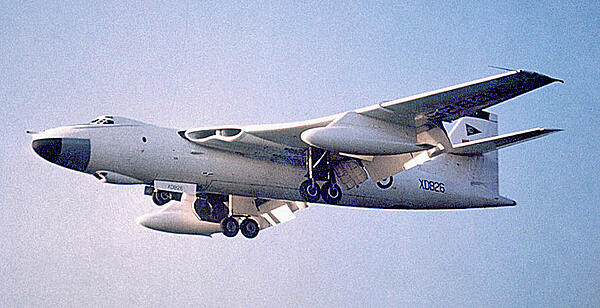The V Bomber Force
The name ‘V Bomber Force’ was the label given to Britain’s dedicated strategic nuclear strike force during the Cold War. This advanced team was made up three different types of bomber including the the Avro Vulcan, the Vickers Valiant and the Handley Page Victor. At the V Bomber Force’s peak, it had 70, 50 and 39, respectively.
Each of these bombers were designed to provide the government with greater freedom from US foreign policy during the Cold War; while Britain was in support of the United States, this separate air defence meant the country wasn’t entirely reliant on bomber support from elsewhere in times of need. This was necessary, for example, during the Suez Crisis in 1956, when America decided it would not deliver any support to the UK and the Vickers Valiant was needed. The Avro Vulcan was also used to support Britain in desperate times, and was used by British pilots in the Falklands War.

The Avro Vulcan
The Avro Vulcan was one of the best known and well-respected of the V bombers, seeing almost thirty years in service. The first of the Avro Vulcan prototypes flew on 30 August 1952 and they were eventually ready for delivery to the RAF bases in July 1956.
The Avro Vulcan was the first V bomber to use a delta-wing (triangular) platform and was specifically designed by the RAF for long-range strategic nuclear bombing. As such, the military used four Rolls-Royce Olympuc 201 turbojet engines to give the plane a top speed of 645 mph at a maximum height of 65,000 feet. On top of this, each Avro Vulcan was able to travel 4,600 miles and could be loaded with up to 21,000 Its of bombs.
Although the first of the vulcan planes was a success, an improved B2 Vulcan was introduced to the RAF in 1960 and could even carry the Blue Steel Missile (weighing 17,000 Ibs).
Despite improvements, the plane fell out of favour following the end of the Falklands War in 1982. The end of the Cold War saw smaller bombers become popular in the RAF, including the Jaguar and the Phantom, and the Avro Vulcan was officially withdrawn from service in 1984.
The Vickers Valiant
The Vickers Valiant was a strategic RAF bomber designed to the same specifications as the Avro Vulcan and the Handley Page Victor and issued in January 1947.
The Valiant was initially rejected by the RAF, with many suggesting it wasn’t advanced enough. However, head Vickers designer George Edward stated that he could build it faster than its counterparts, with a production plane ready to fly by 1953. As such, specification was changed and the Vickers Valiant went into production.
The first Valiant prototype flew in May 1951, and it was just three years later when the first official deliveries were made to the RAF. The finished aircraft was about to reach a maximum speed of 567 mph thanks to its four Rolls-Royce Avon 204 turbojet engines, with a high ceiling height of 54,000 ft and a range of 4,500 miles. Additionally, it was able to carry as much weight as the Avro Vulcan, at 21,000 Ibs.
The Valiant made its name as a critical part of the Suez Crisis, particularly in Operation Musketeer. Specifically, RAF bombers - attempting to stop fighting between Egyptian and Israeli fighters - flew from Malta and Cyprus and attacked twelve airfields in the Canal Zone, destroying the Egyptian Air Force and aiding the capture of key installations. The crisis was so great that the United States Air Force was brought in as a back up, but the Vickers Valiant held its ground.
The plane also played a significant role in the dropping of nuclear weapons in trials through the 1950s and 1960s. However, it was grounded at the end of the decade, having served for just 10 years. Thankfully, the RAF did benefit from the flying techniques learnt by Vickers Valiant pilots, which were used to improve the flying of the Handley Page Victor and the Avro Vulcan.
The Handley Page Victor
The Handley Page Victor was the last V bomber to go into service with the RAF, having not been introduced until 1958. It was particularly recognisable by its crescent-shaped wings - designed to maximise cruising speed - which were based on research being carried out by a number of German companies.
The Victor was powered by four Rolls-Royce Conway Mk 201 turbofan engines and had a top speed of 640 mph, as well as a maximum height of 60,000 ft and a range of 4,600 miles.
Unfortunately, development costs for the Victor were high and expensive, and still left the plane vulnerable to the latest missile technology. As such, the RAF only ordered a small number of the aircraft until the Mark II version was introduced.
The Victor Mark II was specifically designed to carry the American Skybolt IRBM or the Blue Steel missile, but weapons systems developments left the bomber virtually obsolete.
The Victor was also a very expensive plane to run, and as such the RAF spend more money on the smaller bombers such as the Buccaneer, Jaguar and Harrier jump-jet. However, the Victor was still used for photo-reconnaissance and an airborne fuel tanker, which resulted in the planes still being used until more than 40 years later in 1993 when they were finally retired.
MLA Citation/Reference
"The V Bomber Force". HistoryLearning.com. 2026. Web.
